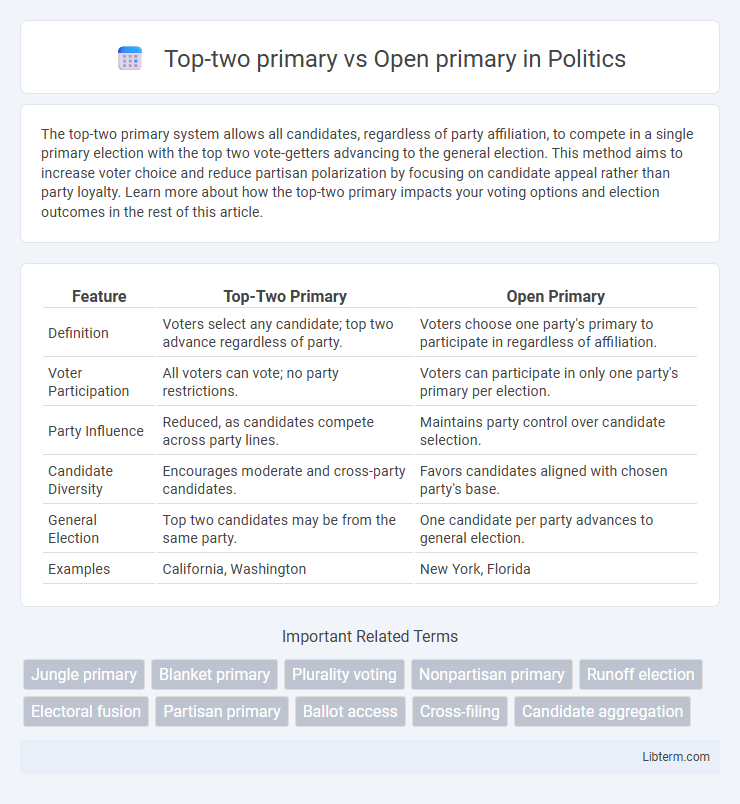The top-two primary system allows all candidates, regardless of party affiliation, to compete in a single primary election with the top two vote-getters advancing to the general election. This method aims to increase voter choice and reduce partisan polarization by focusing on candidate appeal rather than party loyalty. Learn more about how the top-two primary impacts your voting options and election outcomes in the rest of this article.
Table of Comparison
| Feature | Top-Two Primary | Open Primary |
|---|---|---|
| Definition | Voters select any candidate; top two advance regardless of party. | Voters choose one party's primary to participate in regardless of affiliation. |
| Voter Participation | All voters can vote; no party restrictions. | Voters can participate in only one party's primary per election. |
| Party Influence | Reduced, as candidates compete across party lines. | Maintains party control over candidate selection. |
| Candidate Diversity | Encourages moderate and cross-party candidates. | Favors candidates aligned with chosen party's base. |
| General Election | Top two candidates may be from the same party. | One candidate per party advances to general election. |
| Examples | California, Washington | New York, Florida |
Introduction to Primary Election Systems
The top-two primary system allows all candidates to compete in a single primary, with the two highest vote-getters advancing to the general election regardless of party affiliation, promoting broader voter choice. In contrast, the open primary system permits voters to select a party's primary ballot without declaring party membership, enabling participation across party lines while maintaining separate party nominations. Both systems aim to increase voter engagement and influence candidate selection processes in varied ways.
Defining Top-Two Primary: Structure and Process
The top-two primary system restricts the ballot to all candidates regardless of party, allowing voters to select any two candidates, with only the top two vote-getters advancing to the general election. This structure contrasts with the open primary, where voters choose a single party's primary ballot but can participate without party registration. In the top-two primary, the process promotes intra-party competition and aims to present the most broadly popular candidates in the general election, often impacting strategic voting and party dynamics in states like California and Washington.
Understanding Open Primary: How It Works
Open primaries allow all registered voters to participate regardless of party affiliation, increasing democratic involvement and broadening candidate appeal. Voters select one candidate from any party on the primary ballot without declaring party membership, fostering cross-party competition. This system contrasts with top-two primaries where only the top two vote-getters, regardless of party, advance to the general election, often leading to two candidates from the same party competing.
Key Differences Between Top-Two and Open Primaries
Top-two primaries narrow the general election to the two highest vote-getters regardless of party affiliation, promoting more moderate candidates and reducing partisan polarization. Open primaries allow voters of any party to participate in selecting a party's candidate, increasing voter inclusivity but maintaining traditional partisan competition. The key difference lies in candidate advancement: top-two systems can result in same-party general election contenders, while open primaries produce one nominee per party for the general election.
Advantages of Top-Two Primary Elections
Top-two primary elections increase voter choice by allowing all candidates, regardless of party affiliation, to compete on a single ballot, which encourages broader participation and reduces partisan polarization. This system often results in more moderate candidates advancing to the general election, promoting bipartisan appeal and governance. Furthermore, top-two primaries simplify the electoral process and enhance voter engagement by eliminating separate party primaries.
Benefits of Open Primary Elections
Open primary elections enhance voter participation by allowing all registered voters, regardless of party affiliation, to choose any candidate in the primary, increasing inclusivity and representation. This system encourages candidates to appeal to a broader electorate, reducing extreme partisanship and promoting moderate policies. Open primaries also empower independent voters, who often face exclusion in top-two primary systems, strengthening democratic engagement and candidate accountability.
Common Criticisms: Top-Two vs Open Primaries
Top-two primaries often face criticism for limiting voter choice by allowing only the two highest vote-getters, regardless of party affiliation, to advance to the general election. Open primaries are criticized for enabling crossover voting, where members of another party can influence the selection of a candidate in the opposing party, potentially skewing outcomes. Both systems are debated for their impact on voter representation and the promotion of moderate candidates over party-specific preferences.
Voter Participation and Impact on Turnout
Top-two primaries consistently show higher voter participation by allowing all registered voters, regardless of party affiliation, to select from all candidates, increasing engagement across the political spectrum. Open primaries permit unaffiliated voters to participate but often limit party members to their own party's ballot, which can restrict turnout diversity. Studies reveal that top-two systems reduce barriers to voting and lead to broader electorates, positively impacting overall turnout in competitive races.
Real-World Examples: States Implementing Each System
California and Washington are prominent examples of states using the top-two primary system, where all candidates compete in a single primary regardless of party, and the top two vote-getters advance to the general election. In contrast, states like New Hampshire and South Carolina employ open primaries, allowing voters to choose which party's primary to participate in without declaring party affiliation. These differing systems impact voter behavior and election outcomes, with the top-two model often leading to more moderate candidates and the open primary supporting broader party participation.
Which Primary System Promotes Better Representation?
The top-two primary system narrows the general election to the two candidates with the most votes, regardless of party affiliation, often increasing competition and voter choice but risking reduced party diversity. Open primaries allow any registered voter to participate in any party's primary, which can encourage broader voter engagement and better reflect the electorate's preferences. Studies show that open primaries tend to promote more representative outcomes by incorporating a wider spectrum of voter opinions compared to the more restrictive top-two system.
Top-two primary Infographic

 libterm.com
libterm.com